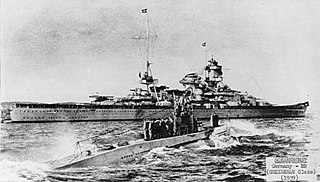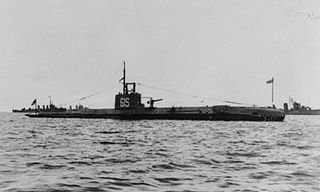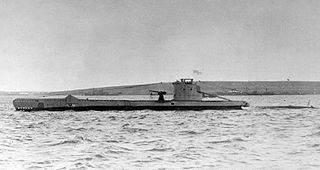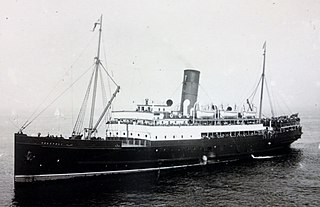
USS S-5 (SS-110) was a "Government-type" S-class submarine of the United States Navy. Her keel was laid down on 4 December 1917 by the Portsmouth Navy Yard of Kittery, Maine. She was launched on 10 November 1919, sponsored by Mrs. Glenn S. Burrell, and commissioned on 6 March 1920 with Lieutenant Commander Charles M. "Savvy" Cooke, Jr., in command. She sank accidentally during full-power trials on 1 September 1920, but due to actions by her crew and the crews of other ships, no lives were lost. Refloated, she was lost when she sank again while under tow on 3 September 1920.

German submarine U-853 was a Type IXC/40 U-boat of Nazi Germany's Kriegsmarine during World War II. Her keel was laid down on 21 August 1942 by DeSchiMAG AG Weser of Bremen. She was commissioned on 25 June 1943 with Kapitänleutnant Helmut Sommer in command. U-853 saw action during the Battle of the Atlantic in World War II. She conducted three patrols, sinking two ships totalling 5,783 tons.

German submarine U-47 was a Type VIIB U-boat of Nazi Germany's Kriegsmarine during World War II. She was laid down on 25 February 1937 at Friedrich Krupp Germaniawerft in Kiel as yard number 582 and went into service on 17 December 1938 under the command of Günther Prien.
HMT Warwick Deeping (H136) was a naval trawler of the British Royal Naval Patrol Service during World War II, sunk off the Isle of Wight in October 1940.

RMS Transylvania was a British Ocean Liner. She was launched on 11 March 1925 for the Anchor Line and was the sister ship to the SS California, and RMS Caledonia. She was converted into an armed merchant cruiser, pennant F56 during World War II. On 10 August 1940, HMS Transylvania was torpedoed and sunk by the German U-boat U-56.

HMS Swordfish (61S) was a first-batch S-class submarine built for the Royal Navy during the 1930s. Commissioned in 1932, she was given the pennant number 61S and was assigned to the 2nd Submarine Flotilla.

HMS Perseus was a British Parthian-class submarine built in 1929 and lost in 1941 during the Second World War. This class were the first to be fitted with Mark VIII torpedoes.

SM UB-81 was a German Type UB III submarine or U-boat in the German Imperial Navy during World War I. She was commissioned into the German Imperial Navy on 18 September 1917 as SM UB-81.

German submarine U-85 was a Type VIIB U-boat of Nazi Germany's Kriegsmarine during World War II.

HMS Urge was a British U-class submarine, of the second group of that class, built by Vickers Armstrong, Barrow-in-Furness. She was laid down on 30 October 1939, and was commissioned on 12 December 1940. From 1941–1942 she formed part of the 10th Submarine Flotilla based in Malta and is the only Royal Navy ship to have borne the name. Urge spent most of her career operating in the Mediterranean, where she damaged or sank a number of Italian warships and merchant vessels and took part in special operations. She was commanded by Lieutenant-Commander Edward Philip Tomkinson, DSO, RN. She was lost with all hands and a number of passengers on 27 April 1942 after striking a German mine off Malta.
German submarine U-486 was a Type VIIC U-boat built for Nazi Germany's Kriegsmarine for service during World War II. She was laid down at the Deutsche Werke in Kiel as yard number 321, launched on 12 February 1944 and commissioned on 22 March with Oberleutnant zur See Gerhard Meyer in command.
The SS Vienna was built in 1873 during the era when steamers were built with sail rigging. She had a 19 year career marked with maritime incidents including sinking when she was just 3 years old. She sank for her final time in fair weather in Whitefish Bay in Lake Superior after she received a mortal blow when she was inexplicably rammed by the steamer Nipigon. Although no lives were lost when the Vienna sank for the last time, more than 100 years later her wreck claimed the lives of 4 scuba divers, the most of all the wrecks in the Whitefish Point Underwater Preserve that now protects her as part of an underwater museum. Her wreck was stripped of artifacts that resulted in the Michigan Department of Natural Resources seizing her artifacts in a raid on the Great Lakes Shipwreck Museum in 1992. Her artifacts are now on display in this museum as loan from the State of Michigan.

RMS Snaefell (III) – the third ship in the line's history to be so named – was a packet steamer operated by the Isle of Man Steam Packet Company from 1910 to 1914. She was then acquired by the Admiralty at the outbreak of the First World War, until she was torpedoed and sunk in the Mediterranean on 5 June 1918.
German submarine U-576 was a Type VIIC U-boat of Nazi Germany's Kriegsmarine during World War II. She carried out five patrols, sinking four ships of 15,450 gross register tons (GRT) and damaging two more of 19,457 GRT. She was sunk in July 1942 by depth charges from two US aircraft and gunfire from a merchant ship, near the East Coast of the United States. The wreck was discovered in August 2014.

The SS Espagne was a Belgian cargo ship that was torpedoed by SM UC-71 in the English Channel off St. Catherine's Point, Isle of Wight, United Kingdom while she was travelling from Le Havre, France to Newport, Monmouthshire, United Kingdom.
SSKeltier was a Belgian cargo ship that was torpedoed by U-55 in the Atlantic Ocean while she was travelling from Milford Haven, Wales, United Kingdom, to New York, United States, in ballast.

German submarine U-1279 was a Type VIIC/41 U-boat of Nazi Germany's Kriegsmarine during World War II.
SS Said was an Egyptian cargo ship that the German submarine U-83 shelled and sunk on 8 June 1942 in the Mediterranean Sea 15 nautical miles (28 km) southwest of Jaffa, Palestine. Said was carrying 50 to 60 tons worth of general cargo including tobacco from Mersin, Turkey to Alexandria, Egypt.











